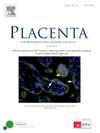高盘绕脐带脐静脉血凝血和纤溶系统:单中心队列研究
IF 3
2区 医学
Q2 DEVELOPMENTAL BIOLOGY
引用次数: 0
摘要
我们的目的是澄清凝血-纤溶系统是否在高盘绕脐带(HCC)中被激活。方法本前瞻性队列研究在日本单一围产期中心进行,包括2024年1月至7月期间妊娠37周后分娩的单胎孕妇。出生后和胎盘娩出前立即采集脐静脉血。测量了凝血和纤溶系统,并比较了HCC患者和非HCC患者之间的变量。结果作为血细胞计数和止血功能的一个变量,血小板浓度在HCC组显著降低[中位数(范围):25.5 (17.3-32.1)vs 30.4 (18.5-39.55) × 100000/μl, p = 0.020]。对于凝血变量,纤维蛋白原浓度[105 (63-116)vs 137.5 (56-229) mg/dl, p <;0.001]和抗凝血酶III[35(27-51)比47.5 (31-62)%,p = 0.022]在HCC组中显著降低。纤溶指标方面,HCC组纤溶酶抑制剂复合物浓度显著高于HCC组[1.3 (1.0-6.9)vs 0.7 (0.3-5.2) μg/ml, p = 0.036];然而,纤溶酶原浓度在HCC组明显降低[40 (32-46)vs 50 (25-64), p <;0.001]。这是首个证实HCC患者脐静脉血中存在凝血-纤溶系统的报告。研究结果显示,即使在妊娠37周后没有严重的HCC胎儿生长限制的情况下,凝血-纤溶系统也被激活。本文章由计算机程序翻译,如有差异,请以英文原文为准。
Coagulation and fibrinolytic system of umbilical venous blood in hyper-coiled umbilical cord: A single center cohort study
Introduction
We aimed to clarify whether the coagulation-fibrinolytic system is activated in a hyper-coiled umbilical cord (HCC).
Methods
This prospective cohort study was conducted at a single perinatal center in Japan, including singleton pregnant women who delivered after 37 weeks of gestation between January and July 2024. Umbilical venous blood was collected immediately after birth and before placental delivery. The coagulation and fibrinolytic systems were measured, and variables were compared between patients with and without HCC.
Results
As a variable of cell blood count and hemostatic function, platelet concentration was significantly lower in the HCC group [median (range): 25.5 (17.3–32.1) vs 30.4 (18.5–39.55) x100000/μl, p = 0.020]. For coagulation variables, fibrinogen concentration [105 (63–116) vs 137.5 (56–229) mg/dl, p < 0.001] and antithrombin III [35 (27–51) vs 47.5 (31–62) %, p = 0.022] were significantly lower in the HCC group. Regarding fibrinolytic variables, plasmin inhibitor complex concentration was significantly higher in HCC group [1.3 (1.0–6.9) vs 0.7 (0.3–5.2) μg/ml, p = 0.036]; however, plasminogen concentration was significantly lower in HCC group [40 (32–46) vs 50 (25–64), p < 0.001].
Discussion
This is the first report where the coagulation-fibrinolytic system in the umbilical venous blood in cases with HCC was demonstrated. Findings reveal an activated coagulation-fibrinolytic system even in cases without severe fetal growth restriction due to HCC after 37 weeks of gestation.
求助全文
通过发布文献求助,成功后即可免费获取论文全文。
去求助
来源期刊

Placenta
医学-发育生物学
CiteScore
6.30
自引率
10.50%
发文量
391
审稿时长
78 days
期刊介绍:
Placenta publishes high-quality original articles and invited topical reviews on all aspects of human and animal placentation, and the interactions between the mother, the placenta and fetal development. Topics covered include evolution, development, genetics and epigenetics, stem cells, metabolism, transport, immunology, pathology, pharmacology, cell and molecular biology, and developmental programming. The Editors welcome studies on implantation and the endometrium, comparative placentation, the uterine and umbilical circulations, the relationship between fetal and placental development, clinical aspects of altered placental development or function, the placental membranes, the influence of paternal factors on placental development or function, and the assessment of biomarkers of placental disorders.
 求助内容:
求助内容: 应助结果提醒方式:
应助结果提醒方式:


